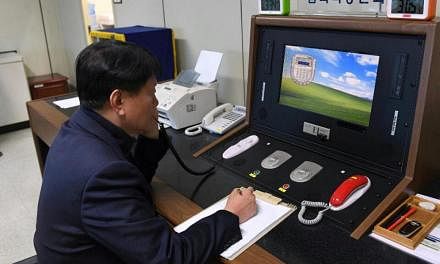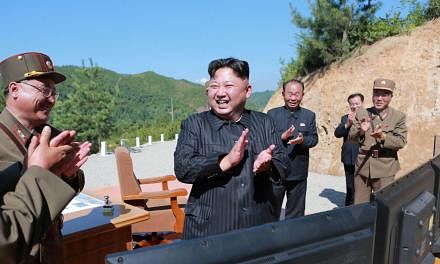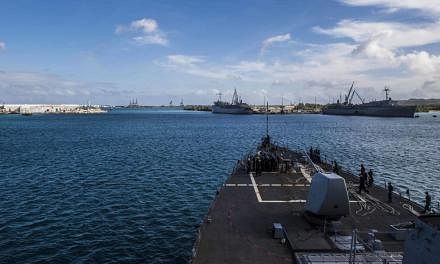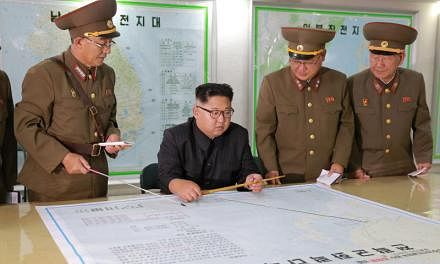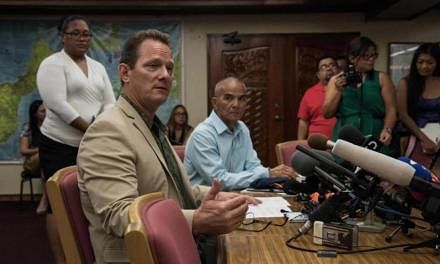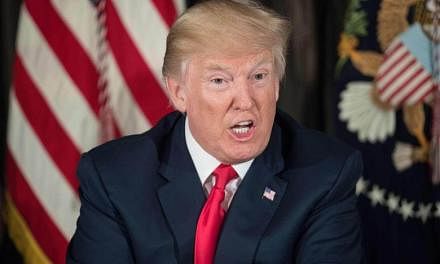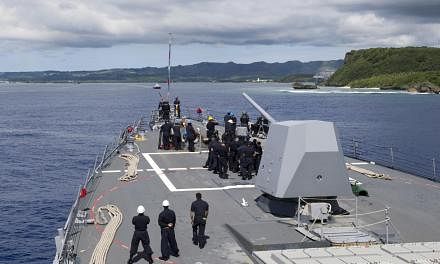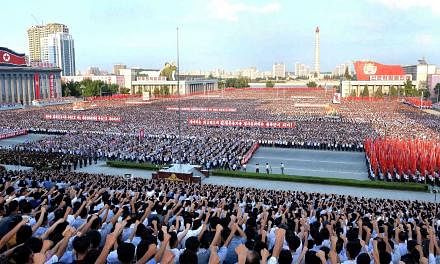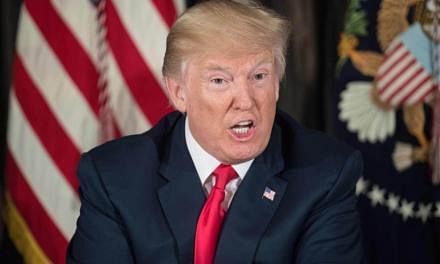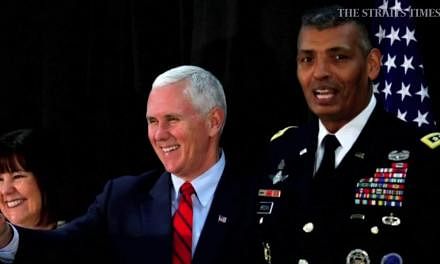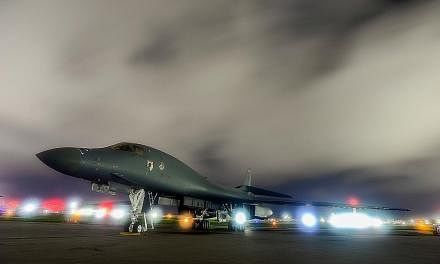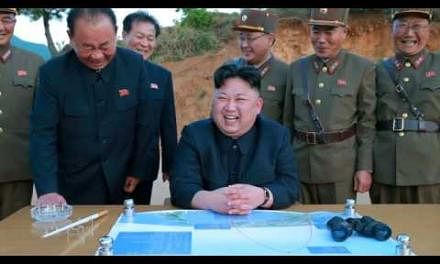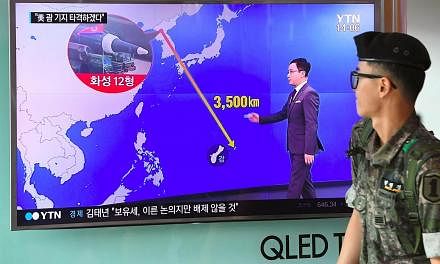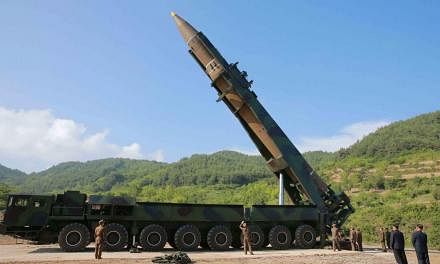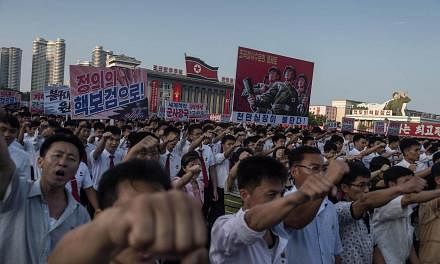SEOUL - North Korea has been conducting missile and nuclear weapons related activities at an unprecedented rate since the beginning of 2017 and is believed to have made some progress in developing intermediate-range and submarine-launched missiles.
Here is a timeline of the country's development of missiles and nuclear weapons:
Late 1970s: North Korea starts working on a version of the Soviet Scud-B (range 300km).
1984: First SCUD-B missile test firing
1987-92: North begins developing variant of Scud-C (500 km), Rodong-1 (1,300 km), Taepodong-1 (2,500 km), Musudan-1 (3,000 km) and Taepodong-2 (6,700 km).
1988: Operational deployment of SCUD-B and SCUD-C missiles
1989: US satellite pictures reveal a nuclear reprocessing plant at North Korea's Yongbyon complex.
1990: First Rodong missile test firing.
1994: The US comes close to war with North Korea over its removal of spent fuel rods from the Yongbyon reactor.
1998: Operational deployment of Rodong missiles. North Korea test-fires its first long-range ballistic missile, a Taepodong-1, over Japan as part of failed satellite launch.
2003: North Korea withdraws from the Nuclear Non-Proliferation Treaty.
2005: North Korea announces its possession of nuclear weapons for the first time, as well as its withdrawal from six-party talks aimed at ending its atomic programme.
July 2006: North Korea test-fires seven missiles, including Rodong, SCUD and a Taepodong-2 that explodes after 40 seconds, triggering United Nations condemnation and sanctions. Taepodong-2 is a long-range missile that could eventually travel 10,000km and be able to strike targets in the United States.
Oct 2006: North Korea's Korean Central News Agency announces a first successful nuclear test.
2007: Operational deployment of Rodong missiles.
April 2009: Firing of Taepodong-2 missile, which North Korea says was satellite launch. United Nations strengthens sanctions and North Korea responds by withdrawing from six-party nuclear disarmament talks. It also and announces it will restart its Yongbyon complex.
May 2009: North Korea carries out second nuclear test.
July 2009: Test-firing of SCUD and Rodong missiles.
Dec 2011: North Korean leader Kim Jong Il dies, son Kim Jong Un takes power.
April 2012: North Korea says Unha-3 rocket launch has failed.
Dec 2012: North Korea launches long-range Unha-3 rocket, which puts its first satellite into space.
Feb 2013: North Korea conducts third underground nuclear test.
Aug 2013: North Korea reported to have restarted nuclear reactor to produce plutonium.
May 2015: North Korea claims to have tested a submarine- launched missile; says it has developed technology to mount nuclear warhead on a missile.
July 2015: North Korea conducts series of missile tests ahead of Chinese President Xi Jinping's visit to Seoul
Sept 2015: North Korea threatens nuclear attack against US and reaffirms its main reactor is operational. South Korean President Park Geun Hye says North would "pay a price" for fourth test.
Dec 3, 2015: Satellite images indicate North Korea is excavating a new tunnel at its main nuclear test site at Punggye-ri, US think-tank says.
Dec 11, 2015: Kim Jong Un says North Korea is "ready to detonate" a hydrogen bomb.
Jan 6, 2016: North Korea carries out fourth nuclear test, saying it has successfully tested a hydrogen bomb.
Feb 7, 2016: North Korea launches a long-range rocket that it says successfully put a satellite into orbit.
March 9, 2016: North Korean leader Kim Jong Un claims his country has successfully miniaturised a thermo-nuclear warhead.
April 15, 2016: North Korea tries, but fails, to test-fire what appears to be a medium-range missile on the birthday of founding leader Kim Il Sung.
April 23, 2016: North Korea test fires a submarine-launched ballistic missile.
Aug 3, 2016: North Korea fires a ballistic missile directly into Japanese-controlled waters for the first time.
Aug 24, 2016: North Korea successfully launches a ballistic missile from a submarine.
Sept 5, 2016: North Korea fires three ballistic missiles about 1,000km, at least one of which entered Japan's air defense zone.
Sept 9, 2016: A shallow magnitude-5.3 earthquake detected near North Korea's nuclear test site is detected, before North Korea announces a fifth nuclear test.
Oct 16, 2016: North Korea fires a ballistic missile that immediately explodes after launch
Feb 12, 2017: North Korea fires its first ballistic missile in 2017, in what is seen as a show of force against the leaders of the United States and Japan reaffirming their security alliance. The missile is believed to be a mid-range Rodong or something similar, flying 500km and landing in the East Sea, also known as Sea of Japan.
March 6, 2017 North Korea fires four ballistic missiles, with three falling into Japan's exclusive economic zone.
April 16, 2017: North Korea fires an unidentified ballistic missile that explodes almost immediately after launch, defying warnings from the Trump administration to avoid any further provocations
April 29, 2017: In an apparent defiance of a concerted US push for tougher international sanctions to curb Pyongyang's nuclear weapons ambitions, the country test-fires a ballistic missile from the Pukchang region in a north-easterly direction. The missile reaches an altitude of 71 km before disintegrating a few minutes into flight
SOURCE: BLOOMBERG, AGENCE FRANCE-PRESSE



